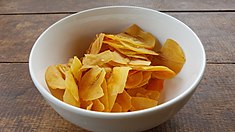 | |
| Alternative names | Banana Crisp (British English) |
|---|---|
| Type | Crisps |
| Course | Deep-fried snack, side dish |
| Serving temperature | Room temperature |
 Banana chips from the Philippines | |||||||||||||||||||||||||||||||||||||||||||||||||
| Nutritional value per 100g | |||||||||||||||||||||||||||||||||||||||||||||||||
|---|---|---|---|---|---|---|---|---|---|---|---|---|---|---|---|---|---|---|---|---|---|---|---|---|---|---|---|---|---|---|---|---|---|---|---|---|---|---|---|---|---|---|---|---|---|---|---|---|---|
| Energy | 2,170 kJ (520 kcal) | ||||||||||||||||||||||||||||||||||||||||||||||||
58.40g | |||||||||||||||||||||||||||||||||||||||||||||||||
| Sugars | 35.34g | ||||||||||||||||||||||||||||||||||||||||||||||||
| Dietary fiber | 7.7g | ||||||||||||||||||||||||||||||||||||||||||||||||
33.60g | |||||||||||||||||||||||||||||||||||||||||||||||||
| Saturated | 28.970g | ||||||||||||||||||||||||||||||||||||||||||||||||
| Monounsaturated | 1.950g | ||||||||||||||||||||||||||||||||||||||||||||||||
| Polyunsaturated | 0.630g | ||||||||||||||||||||||||||||||||||||||||||||||||
2.30g | |||||||||||||||||||||||||||||||||||||||||||||||||
| |||||||||||||||||||||||||||||||||||||||||||||||||
| Other constituents | Quantity | ||||||||||||||||||||||||||||||||||||||||||||||||
| Water | 4.3 g | ||||||||||||||||||||||||||||||||||||||||||||||||
| †Percentages estimated using US recommendations for adults,[1] except for potassium, which is estimated based on expert recommendation from the National Academies.[2] | |||||||||||||||||||||||||||||||||||||||||||||||||
A banana chip (sometimes called banana crisp) is a deep-fried or dried, generally crispy slice of banana. It is usually made from firmer, starchier banana varieties ("cooking bananas" or plantains) like the saba and Nendran cultivars. It can be sweet or savory and can be covered with sugar, honey, salt, or various spices.[3][4]
Banana chips are the only processed banana product with significant international trade. The main exporter of banana chips worldwide is the Philippines. Export markets for banana chips are also established in Thailand and Indonesia.[5][6]
- ^ United States Food and Drug Administration (2024). "Daily Value on the Nutrition and Supplement Facts Labels". FDA. Archived from the original on 2024-03-27. Retrieved 2024-03-28.
- ^ National Academies of Sciences, Engineering, and Medicine; Health and Medicine Division; Food and Nutrition Board; Committee to Review the Dietary Reference Intakes for Sodium and Potassium (2019). Oria, Maria; Harrison, Meghan; Stallings, Virginia A. (eds.). Dietary Reference Intakes for Sodium and Potassium. The National Academies Collection: Reports funded by National Institutes of Health. Washington, DC: National Academies Press (US). ISBN 978-0-309-48834-1. PMID 30844154. Archived from the original on 2024-05-09. Retrieved 2024-06-21.
- ^ mis.dost.gov.ph. "How to Make Sweet and Salted Banana Chips". EntrePinoys Atbp. Archived from the original on 28 December 2011. Retrieved 16 May 2012.
- ^ Cite error: The named reference
Pillaywas invoked but never defined (see the help page). - ^ Robinson, John Charles; Galán Saúco, Víctor (2010). Bananas and Plantains. CABI. p. 16. ISBN 978-1-84593-738-6.
- ^ Molina, A.; Valmayor, R. V. (1999). "Banana Production Systems in Southeast Asia". In Picq, C.; Fouré, E.; Frison, E. A. (eds.). Bananas and Food Security / Les productions bananières: un enjeu économique majeur pour la sécurité alimentaire. Bioversity International. p. 434.